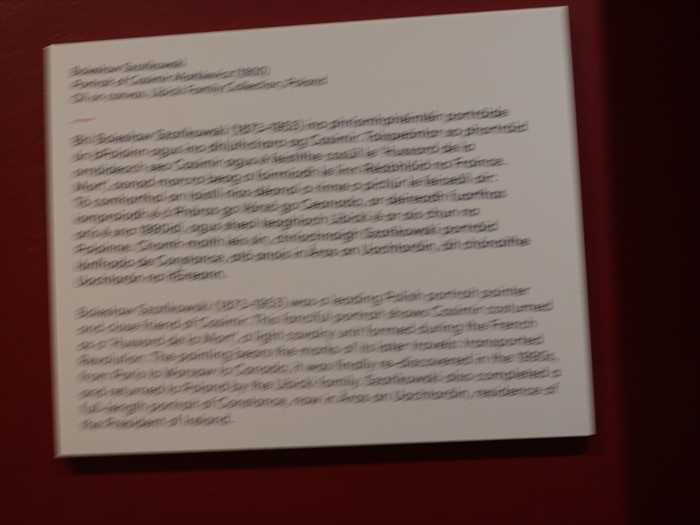PR
X
Keyword Search
▼キーワード検索
Comments
2週連続で岡山県立…
 New!
隠居人はせじぃさん
New!
隠居人はせじぃさん
【南京櫨の紅葉 ・ … New!
Gママさん
New!
Gママさん
続日本100名城東北の… New! オジン0523さん
エコハウスにようこそ ecologicianさん
noahnoah研究所 noahnoahnoahさん
 New!
隠居人はせじぃさん
New!
隠居人はせじぃさん【南京櫨の紅葉 ・ …
 New!
Gママさん
New!
Gママさん続日本100名城東北の… New! オジン0523さん
エコハウスにようこそ ecologicianさん
noahnoah研究所 noahnoahnoahさん
Calendar
カテゴリ: 海外旅行
ダブリン城(Dublin Castle)のState Apartments に収蔵されている絵画・彫刻コレクション
の見学のために開館の10:00を待つ。
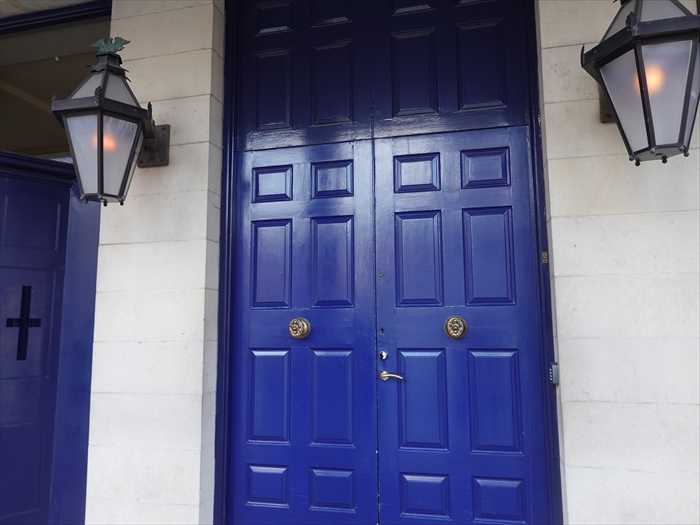
そして10:00になり開館。
ダブリン城(Dublin Castle)内の 「ステート・アパートメント(State Apartments)」にある
グレート・ステアケース(Great Staircase) 前へ。
赤いカーペットと金の手すり飾りが特徴 の、儀礼用の 大階段(Grand Staircase) 。
カーテンは濃赤色のドレープに金の縁取り 。儀式的・格式ある印象を与えるのであった。
この階段は、国王や女王、賓客がステート・アパートメントの公式行事に向かう際に使用する
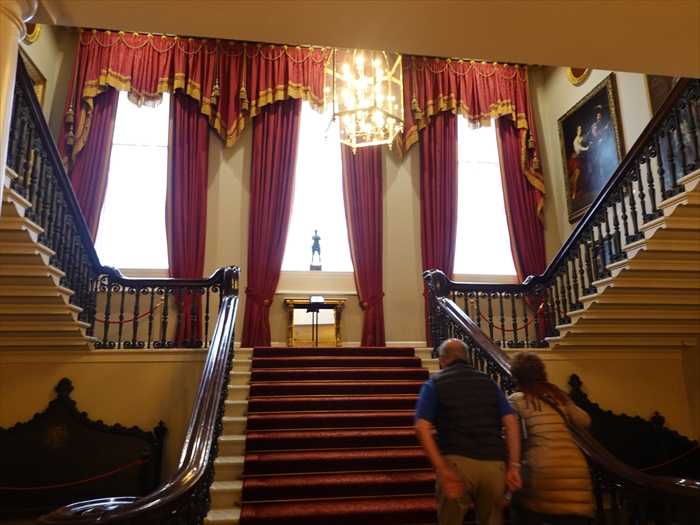
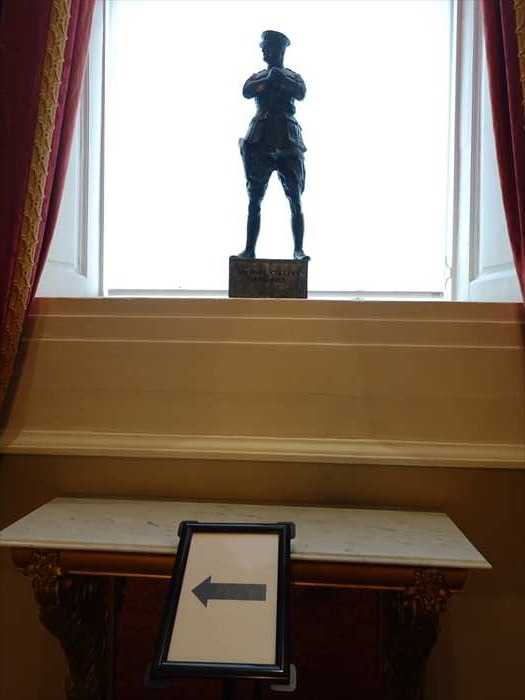
この絵画は、キリスト教美術における非常に典型的な主題である「ピエタ(Pietà)」または
「十字架降架(The Deposition / The Descent from the Cross)」を描いたもの。

「Art, theatre, and liberation: these common threads linked the lives of Casimir and
Constance Markievicz.
For Constance, this was the beginning of her political awakening. They also found
themselves in dispute with these movements of possibility and promise – some realised,
and others not – and of Casimir’s place in a city where (in the words of W.B. Yeats)
a ‘terrible beauty’ would soon be born.」
【芸術、演劇、そして解放——これらの共通した糸が、カジミールとコンスタンス・マルキェヴィチ
の人生を結びつけました。
の見学のために開館の10:00を待つ。

そして10:00になり開館。
ダブリン城(Dublin Castle)内の 「ステート・アパートメント(State Apartments)」にある
グレート・ステアケース(Great Staircase) 前へ。
赤いカーペットと金の手すり飾りが特徴 の、儀礼用の 大階段(Grand Staircase) 。
カーテンは濃赤色のドレープに金の縁取り 。儀式的・格式ある印象を与えるのであった。
この階段は、国王や女王、賓客がステート・アパートメントの公式行事に向かう際に使用する
この階段を上がると、以下のような部屋へつながっていた。
1.Throne Room(玉座の間)
2.State Drawing Room(謁見室)
3.St. Patrick’s Hall(セント・パトリックス・ホール)
4.Battleaxe Landing(戦斧の間)

中央の像。
窓の中央に小像が飾られており、光を背にしてシルエット状になっていた。
「Michael Collins(マイケル・コリンズ)像」。
「Michael Collins(マイケル・コリンズ)像」。
・Michael Collins(マイケル・コリンズ)(1890–1922)
アイルランド独立運動の指導者の一人。アイルランド独立戦争(1919–1921)では、
IRA(アイルランド共和軍)の諜報活動を組織し、ゲリラ戦を展開しました。
1921年の 英愛条約 に署名し、アイルランド自由国の成立に大きく貢献しましたが、
この妥協的な条約が国内で分裂を招き、1922年の内戦中に暗殺されました。
IRA(アイルランド共和軍)の諜報活動を組織し、ゲリラ戦を展開しました。
1921年の 英愛条約 に署名し、アイルランド自由国の成立に大きく貢献しましたが、
この妥協的な条約が国内で分裂を招き、1922年の内戦中に暗殺されました。
その死はアイルランドにとって大きな衝撃であり、英雄的な存在として今日まで
記憶されています。
記憶されています。
・像の特徴
小像は、両腕を組んで立つコリンズの姿を表現しており、軍服姿で毅然とした態度を
示しています。
これは、彼のリーダーシップと独立への強い意志を象徴していると解釈できます。
示しています。
これは、彼のリーダーシップと独立への強い意志を象徴していると解釈できます。
・展示の意味
ダブリン城はイギリス統治時代に総督府として使われてきた象徴的な建物です。
その中の State Apartments にコリンズ像が置かれていること自体が、歴史の逆転
(植民地支配から独立への転換)を示す記念的な配置と考えられます。
その中の State Apartments にコリンズ像が置かれていること自体が、歴史の逆転
(植民地支配から独立への転換)を示す記念的な配置と考えられます。

この絵画は、キリスト教美術における非常に典型的な主題である「ピエタ(Pietà)」または
「十字架降架(The Deposition / The Descent from the Cross)」を描いたもの。
・中央の人物
体は布に包まれて横たわっています。
体は布に包まれて横たわっています。
・ 左後方の人物
:キリストの遺体を支えている男性は、伝統的に ヨセフ・アリマタヤ
(または ニコデモ)とされることが多い。
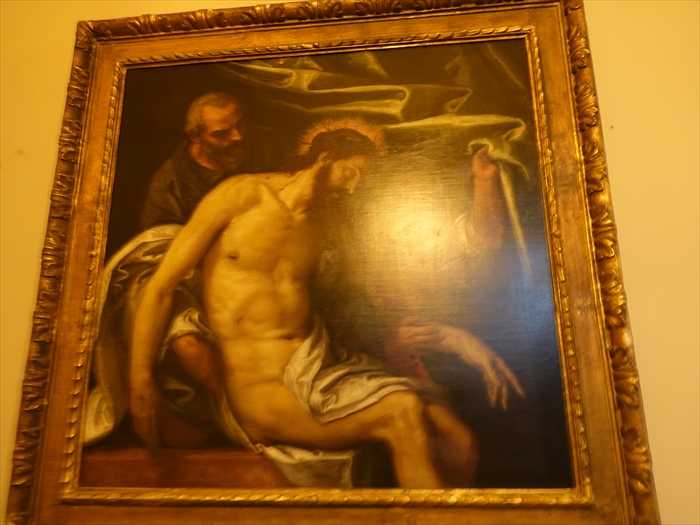
この絵画もまた、キリスト教美術において非常に重要な主題の一つである「キリストの埋葬
(The Lamentation / Entombment of Christ)」または「ピエタ」に属する作品。
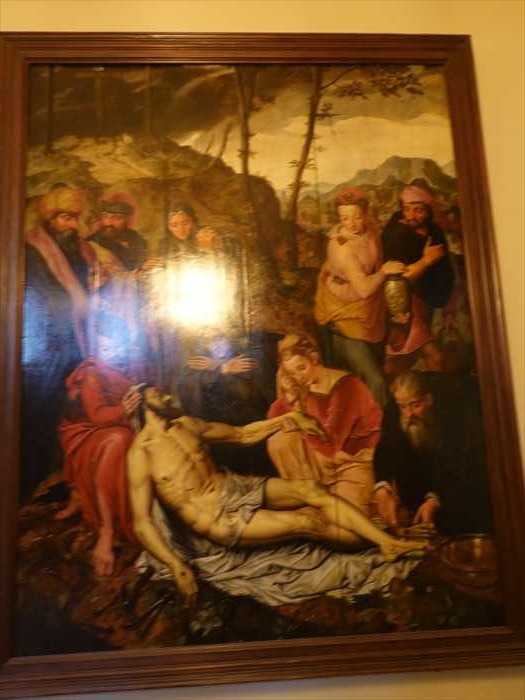
キリスト教美術における壮大な主題「 最後の審判(Last Judgment) 」を描いた作品。
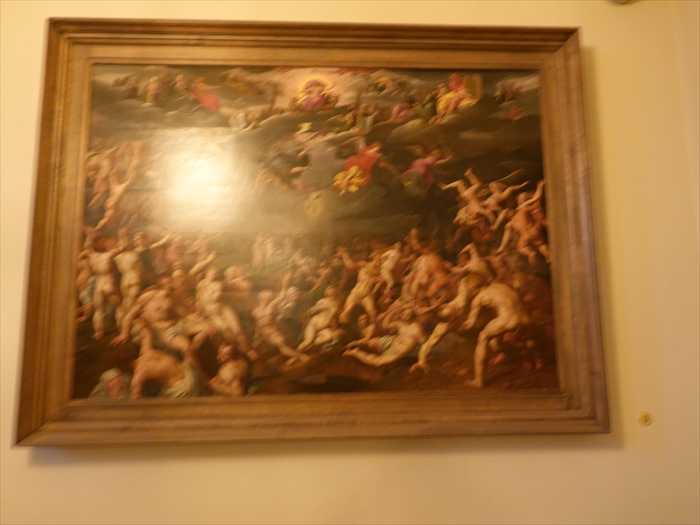

この絵画は、聖書に登場する「 放蕩息子の物語(The Parable of the Prodigal Son) 」を
描いたもの。
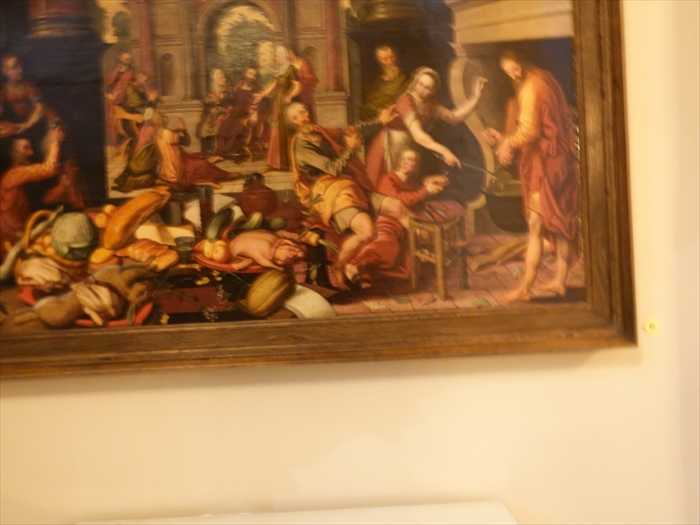
この写真には、3枚の異なる様式・主題の絵画が壁に展示されている様子が。
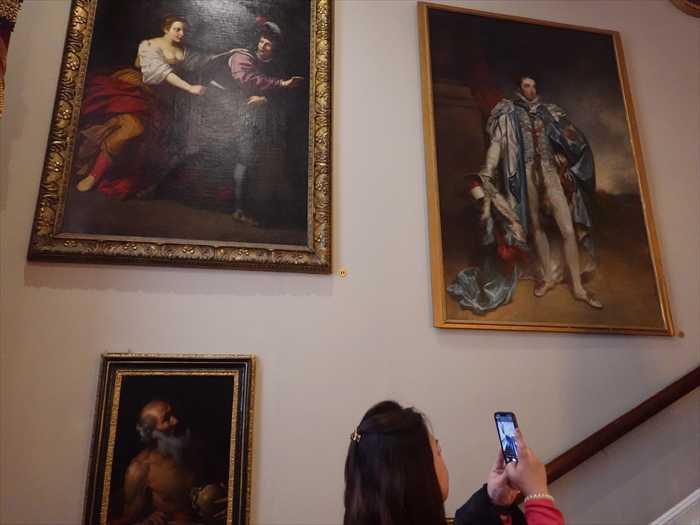
この絵画は、キリスト教美術において非常に典型的な主題のひとつである
「聖ヒエロニムス(St. Jerome)」を描いた作品。

グレート・ステアケース(Great Staircase)の反対側 を見る。



聖書の有名な場面「足を洗うイエス(Christ Washing the Disciples’ Feet) 」を描いたもの。
非常に特徴的な構図と光の表現から、レンブラント(Rembrandt)やその周辺のオランダ
黄金時代の画家たち(17世紀)による様式に近い作品 と。

上品な額縁に収められた 男性の肖像画 。
肩にかけた青い帯(サッシュ)は、貴族・勲爵士・政治家・騎士団の象徴であることが多く、
名誉職や高位の官職に就いていた可能性を示唆 と。

アイルランド総督(Lord Lieutenant of Ireland=Viceroy of Ireland) か?
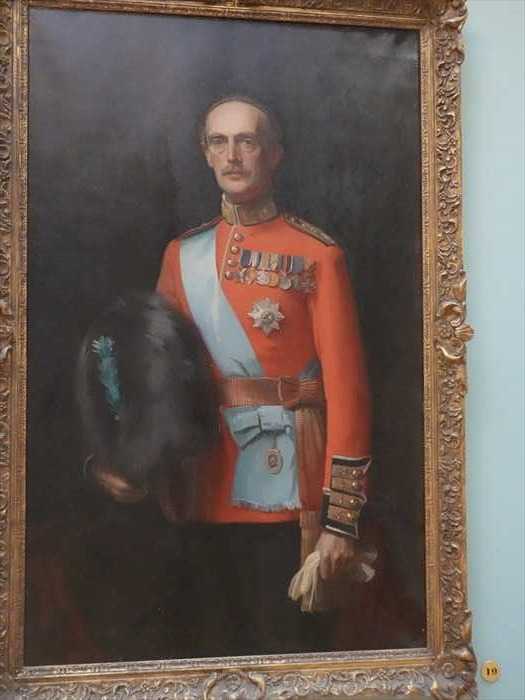

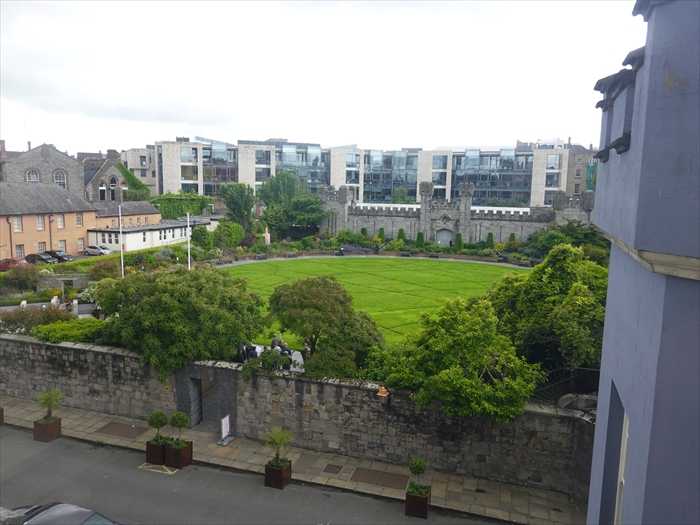
1916年のイースター蜂起(Easter Rising)に関わった指導者たち を描いたもの と。
蜂起の指導者たちが処刑される前に撮影された写真や記録を元に描かれたペン画。
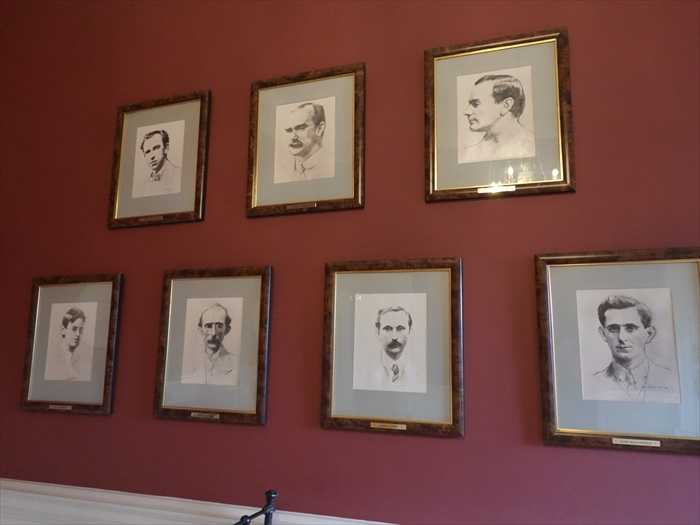
1916年のイースター蜂起の指導者 ジェームズ・コノリー(James Connolly) に
関する記念文 が刻まれているプレート。
「IN THIS ROOM
(または ニコデモ)とされることが多い。

この絵画もまた、キリスト教美術において非常に重要な主題の一つである「キリストの埋葬
(The Lamentation / Entombment of Christ)」または「ピエタ」に属する作品。
登場人物:
1.中央下部:
亡くなった イエス・キリスト の遺体。
2.キリストの右側(赤い衣の女性)
:多くの場合、マグダラのマリア。涙を流しながら
キリストに触れている。
キリストに触れている。
3.キリストの頭を支える男性:
伝統的には ヨセフ・アリマタヤ や ニコデモ。
4.黒い服の女性(後方中央):
聖母マリア。喪服を着て祈るようにうなだれている。
5.右手前の男性:たらいに手を入れていることから、ニコデモ が遺体の香油塗布や洗浄を
している場面かもしれません。
している場面かもしれません。
6.背景の人物たち:
他の弟子、女性たち(例:サロメ、マルタなど)と考えられます。
右手の壺を持った女性は、香油壺を持つマグダラのマリアの象徴かも
しれません。
右手の壺を持った女性は、香油壺を持つマグダラのマリアの象徴かも
しれません。

キリスト教美術における壮大な主題「 最後の審判(Last Judgment) 」を描いた作品。
下部(地上):
・多くの裸の人々が混乱し、叫び、引きずられたり、落下したりしている様子が見えます。
・地獄に落ちる罪人や、天に召される義人たちが混在。
・地面から引き上げられる者・落とされる者が描かれており、救済と裁きの瞬間を表しています。
上部(天上):
・雲に乗る神的存在(おそらく キリスト)と、周囲に天使や聖人たちの姿。
・天使はラッパ(審判の開始を告げる)を吹いている可能性あり。
・左右に分かれた構図は、天国へ行く者と地獄へ堕ちる者の二極構造を暗示しています。

「 State Apartments(ステート・アパートメンツ)
」 に関する展示パネル。
「THE STATE APARTMENTS
Dublin Castle was the seat of English power in Ireland for over 700 years. In the eighteenth
century, the medieval castle was gradually transformed into a Georgian palace
for the Viceroy (the King’s representative) and the British administration.
century, the medieval castle was gradually transformed into a Georgian palace
for the Viceroy (the King’s representative) and the British administration.
Designed by the architect Thomas Burgh, the State Apartments formed the public rooms for official state functions, such as balls, receptions, banquets, and court gatherings.
Located on the first floor, the State Apartments followed the sequence of a grand house, with reception rooms leading to a throne room and private chambers.
On 16 January 1922, the last Viceroy handed Dublin Castle over to Michael Collins and
the new Irish government. This symbolic moment marked the foundation of the Irish
Free State, which would later become the Republic of Ireland.
the new Irish government. This symbolic moment marked the foundation of the Irish
Free State, which would later become the Republic of Ireland.
Today the ceremonial State Apartments are used for state functions such as presidential inaugurations, official visits, and diplomatic receptions.」
【 ステート・アパートメンツ
【 ステート・アパートメンツ
ダブリン城は、700年以上にわたりイングランドのアイルランド支配の拠点でした。18世紀に
なると、中世の城は徐々に改築され、副王(イギリス王の代理人)と英国統治機構のための
ジョージ王朝風の宮殿へと姿を変えていきました。
なると、中世の城は徐々に改築され、副王(イギリス王の代理人)と英国統治機構のための
ジョージ王朝風の宮殿へと姿を変えていきました。
建築家トーマス・バーグ(Thomas Burgh)によって設計されたステート・アパートメンツは、
舞踏会、レセプション、晩餐会、法廷の集まりなど、公式の国家行事のための公的な部屋として
使用されました。
舞踏会、レセプション、晩餐会、法廷の集まりなど、公式の国家行事のための公的な部屋として
使用されました。
これらの部屋は1階(日本でいう2階)に位置し、壮麗な邸宅の構成に従っており、謁見室から
玉座の間、そして私的な居室へと続いています。
玉座の間、そして私的な居室へと続いています。
1922年1月16日、最後の副王がダブリン城をマイケル・コリンズと新しいアイルランド政府へと
引き渡しました。この象徴的な出来事は、後にアイルランド共和国となるアイルランド自由国の
誕生を意味するものでした。
引き渡しました。この象徴的な出来事は、後にアイルランド共和国となるアイルランド自由国の
誕生を意味するものでした。
現在、この儀式用のステート・アパートメンツは、大統領就任式、公式訪問、外交レセプション
など、国家的な儀式の場として使用されています。】
など、国家的な儀式の場として使用されています。】

この絵画は、聖書に登場する「 放蕩息子の物語(The Parable of the Prodigal Son) 」を
描いたもの。
・手前左側には豪華なごちそうや果物、酒などが散乱しており、享楽にふける場面が
描かれています。
描かれています。
・右側中央では、女性たちとともに贅沢な生活を送る若者が描かれており、金銭や贅沢な暮らしが
見て取れます。
見て取れます。
・背景の建物の中には別の人物たちが描かれており、物語の後半の場面(悔い改めや帰郷)へ
つながる暗示かもしれません。
つながる暗示かもしれません。

この写真には、3枚の異なる様式・主題の絵画が壁に展示されている様子が。

この絵画は、キリスト教美術において非常に典型的な主題のひとつである
「聖ヒエロニムス(St. Jerome)」を描いた作品。
・老人の裸身上半身(しばしば苦行者や隠者の象徴)
・長い白髭
・頭蓋骨(スカル)を持っている(死と瞑想、儚さ〈memento mori〉の象徴)
・本・聖書に手を置いている(聖書翻訳に携わったことを象徴)
・暗い背景に強い光が当たるカラヴァッジョ風の明暗対比(キアロスクーロ)
強い光と闇のコントラスト、肉体表現のリアリズムから見て、バロック期(17世紀)のイタリア
またはスペインの画家による作品と考えられる と。
またはスペインの画家による作品と考えられる と。

グレート・ステアケース(Great Staircase)の反対側 を見る。

「 グランド・ステアケース(The Grand Staircase)
」に関する説明を提供。

「 THE GRAND STAIRCASE
“This great imperial staircase of three broad flights was a historic visual statement of
power and has been immortalised with a now world-famous image of debutantes in
white presentation gowns being received with choreographed elegance on the State
Apartments’ landing by Ireland’s Lord Lieutenant and members of his court. Originally
this castle was so ill-lit that, in their high-heeled shoes, debutantes and presentation
women given to the Viceroy, often assisted by the Presentation Marshal, had to cling
to the staircase walls for balance, giving the stairwell the temporary title, ‘the wailing wall.”
power and has been immortalised with a now world-famous image of debutantes in
white presentation gowns being received with choreographed elegance on the State
Apartments’ landing by Ireland’s Lord Lieutenant and members of his court. Originally
this castle was so ill-lit that, in their high-heeled shoes, debutantes and presentation
women given to the Viceroy, often assisted by the Presentation Marshal, had to cling
to the staircase walls for balance, giving the stairwell the temporary title, ‘the wailing wall.”
— From the Dublin Castle Guidebook」
【 グランド・ステアケース(大階段)
この壮大な3層構造の大階段は、権力の視覚的象徴として歴史的に重要なものであり、
白いドレス姿のデビュタント(社交界への初登場の若い女性たち)が、アイルランド副王
(ロード・リューテナント)とその廷臣たちによって、国家アパートメントの踊り場で
迎えられる様子を描いた、現在では世界的に有名となった画像によって不朽のものと
なっています。
白いドレス姿のデビュタント(社交界への初登場の若い女性たち)が、アイルランド副王
(ロード・リューテナント)とその廷臣たちによって、国家アパートメントの踊り場で
迎えられる様子を描いた、現在では世界的に有名となった画像によって不朽のものと
なっています。
当時、この城は非常に薄暗く照明が乏しかったため、ハイヒールを履いたデビュタントや
紹介される女性たちは、階段の壁にしがみついて登らなければならなかったといいます。
このことから、この階段は一時的に『嘆きの壁(the wailing wall)』と呼ばれることも
ありました。
紹介される女性たちは、階段の壁にしがみついて登らなければならなかったといいます。
このことから、この階段は一時的に『嘆きの壁(the wailing wall)』と呼ばれることも
ありました。
- ダブリン城ガイドブックより】

聖書の有名な場面「足を洗うイエス(Christ Washing the Disciples’ Feet) 」を描いたもの。
非常に特徴的な構図と光の表現から、レンブラント(Rembrandt)やその周辺のオランダ
黄金時代の画家たち(17世紀)による様式に近い作品 と。
・中央の人物は上半身裸に布をまとい、足を洗ってもらっているように見える。
・その足元で跪いて作業をしている人物がいる(おそらくイエス・キリスト)。

上品な額縁に収められた 男性の肖像画 。
肩にかけた青い帯(サッシュ)は、貴族・勲爵士・政治家・騎士団の象徴であることが多く、
名誉職や高位の官職に就いていた可能性を示唆 と。

アイルランド総督(Lord Lieutenant of Ireland=Viceroy of Ireland) か?

ジョン・ウィリアム・ポンソンビー 第4代ベスバラ伯(John William Ponsonby, 4th Earl of Bessborough)
。
アイルランド総督(Lord Lieutenant of Ireland)を務めた人物(在任:1846–1847)
このベスバラ伯の肖像は、星章やバッジを身につけた格式ある姿で描かれていた。

ダブリン城(Dublin Castle)の中庭にある「 ダブリン・ガーデン(Dublin Gardens)
」を上から
眺めた景色。
眺めた景色。
円形の芝生
と、 その外周を囲む歩道
、さらに 背景に見える城壁と近代的なビル群
が特徴的。

1916年のイースター蜂起(Easter Rising)に関わった指導者たち を描いたもの と。
蜂起の指導者たちが処刑される前に撮影された写真や記録を元に描かれたペン画。

1916年のイースター蜂起の指導者 ジェームズ・コノリー(James Connolly) に
関する記念文 が刻まれているプレート。
「IN THIS ROOM
JAMES CONNOLLY
SIGNATORY TO THE
PROCLAMATION OF THE IRISH REPUBLIC
LAY A WOUNDED PRISONER
PRIOR TO HIS EXECUTION BY
THE BRITISH MILITARY FORCES
AT KILMAINHAM JAIL AND HIS INTERMENT
AT ARBOUR HILL
12TH MAY 1916」
【この部屋で
【この部屋で
ジェームズ・コノリー
アイルランド共和国樹立宣言の署名者は、
負傷した捕虜として横たわっていた。
それは、彼がキルメイナム刑務所で
イギリス軍によって処刑され、
その後アーバー・ヒルに埋葬される前のことであった。
1916年5月12日】
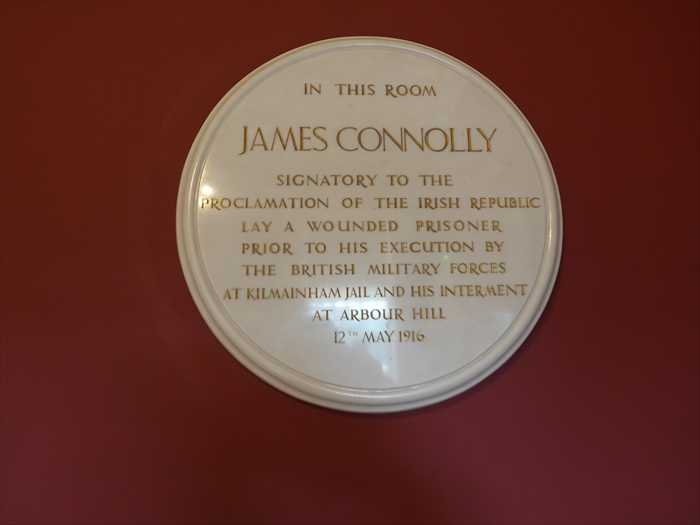
こちらは、アイルランド語(ゲール語)で記したプレート。

ステート・アパートメンツ(State Apartments) 内にある「 アーチ型天井の豪華な廊下 」。
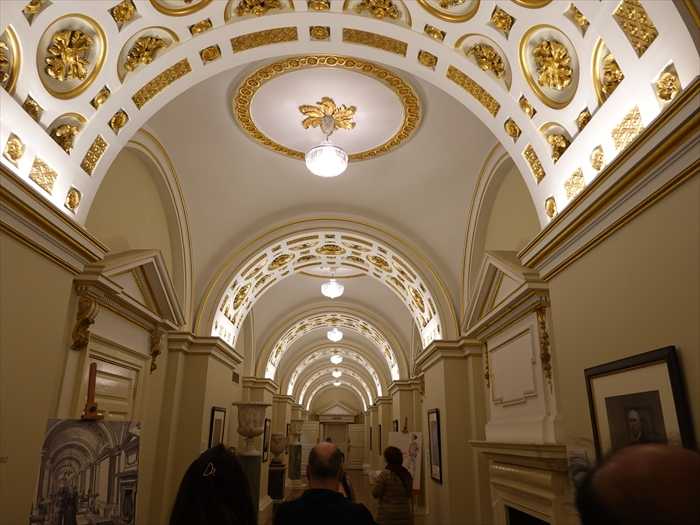
ズームして。
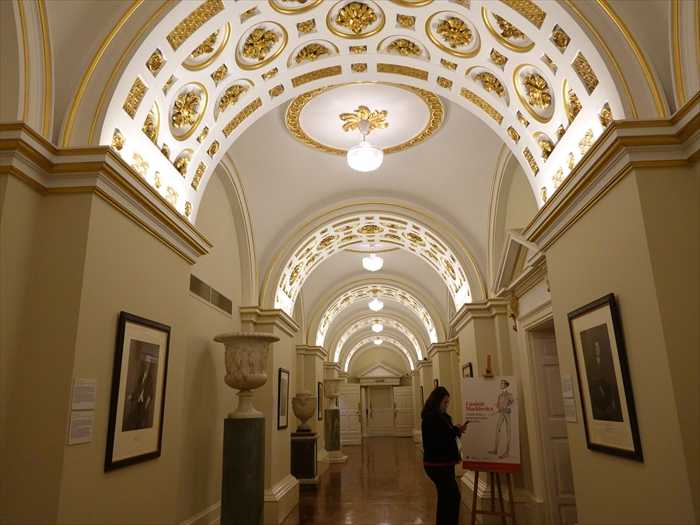
が。
「DUBLIN CASTLE

こちらは、アイルランド語(ゲール語)で記したプレート。

ステート・アパートメンツ(State Apartments) 内にある「 アーチ型天井の豪華な廊下 」。
・装飾様式
白地に金色のレリーフを施した豪華な天井装飾が特徴で、円形や楕円形のパネルには花や葉の
モチーフが浮き彫りになっています。
モチーフが浮き彫りになっています。
このような金色と白の組み合わせは、18〜19世紀の新古典主義(Neoclassical)建築装飾に
多く見られます。
多く見られます。
・アーチ構造
複数の連続した半円アーチが廊下に奥行きを与え、遠近感を強調しています。
アーチ部分にも細かいモールディング(額縁状の装飾)が施されています。
・用途
この廊下は「ステート・アパートメンツ」内の主要な動線のひとつで、公式行事や一般公開時
には訪問者が各部屋へアクセスする際に通るエリアです。
には訪問者が各部屋へアクセスする際に通るエリアです。
現在は壁に肖像画や説明パネルが並び、小規模な展示ギャラリーとしても使われています。

ズームして。

が。
「DUBLIN CASTLE
Éist anseo lenár dtreoráí fuaime saor in aisce. Scan an QR cód
Listen to our free audio guide here. Scan the QR code
[QRコード]
こちらで当城の無料音声ガイドをお聴きください。QRコードをスキャンしてください。
(QRコード)】

柔らかな光と陰影の中で、両腕を前に組んで頭を乗せる姿勢の少女。

様々な作品が。
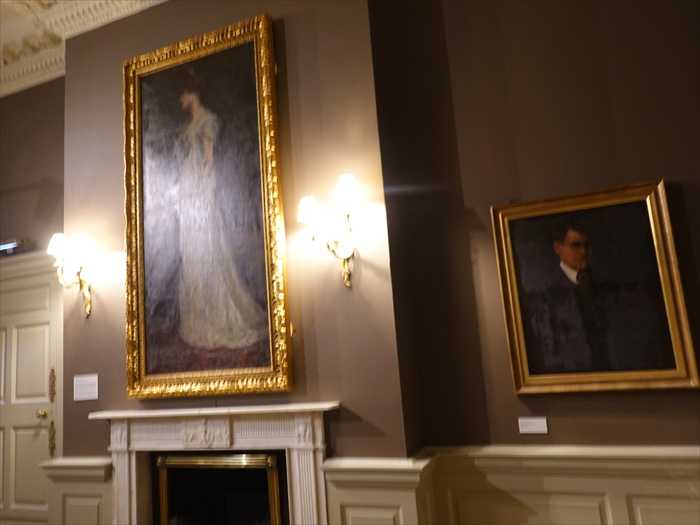
全身を縦長の構図で描いた女性の肖像画で、豪華な金の額縁に収められていた。
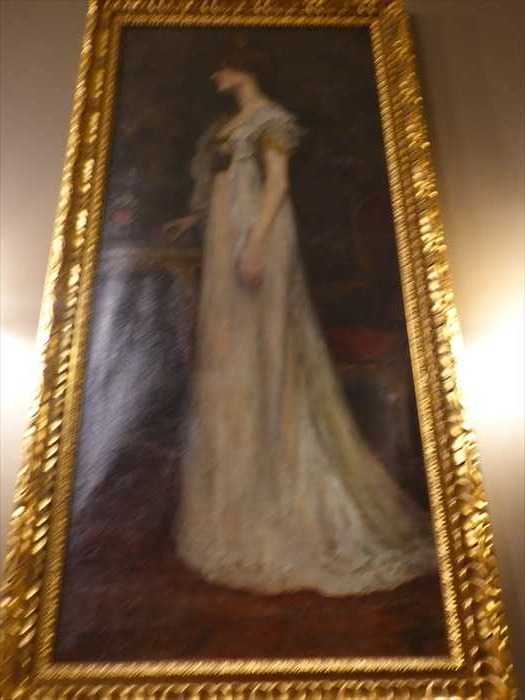

柔らかな光と陰影の中で、両腕を前に組んで頭を乗せる姿勢の少女。

様々な作品が。

全身を縦長の構図で描いた女性の肖像画で、豪華な金の額縁に収められていた。

「 Casimir Markievicz
A Polish Artist in Bohemian Dublin (1903–1913)
」
【カジミール・マルキェヴィチはダブリンの芸術・文学界(ボヘミアン・ダブリン)で活躍した
ポーランド出身の画家】
【カジミール・マルキェヴィチはダブリンの芸術・文学界(ボヘミアン・ダブリン)で活躍した
ポーランド出身の画家】

「Art, theatre, and liberation: these common threads linked the lives of Casimir and
Constance Markievicz.
Constance Gore-Booth (1868–1927), the daughter of Anglo-Irish gentry, was destined to
become one of Ireland’s revolutionary heroines. Casimir Markievicz (1874–1932),
a Polish gentleman born in Ukraine, was an artist with an irrepressible zest for life and
adventure.
become one of Ireland’s revolutionary heroines. Casimir Markievicz (1874–1932),
a Polish gentleman born in Ukraine, was an artist with an irrepressible zest for life and
adventure.
In Ireland, the name ‘Markievicz’ instantly conjures the figure of Constance; this exhibition
seeks to bring Casimir back into the frame, re-positioning him as a central player
in Dublin’s bohemian life before the Revolution.
seeks to bring Casimir back into the frame, re-positioning him as a central player
in Dublin’s bohemian life before the Revolution.
They met as art students in Paris and married in London in 1900, and from 1903–13
‘Casi and Con’ made Dublin their home. In a city teeming with rival theatrical factions,
writers, philosophers, and visionaries of the Irish Revival, they pursued their artistic
ambitions. It was a decade of competing visions of what art could be, of how theatre and
art might inform politics (and vice versa), and of the uncertain fate lay ahead for
Ireland as a nation.
For Casimir, this meant experimenting with new forms of artistic self-expression.‘Casi and Con’ made Dublin their home. In a city teeming with rival theatrical factions,
writers, philosophers, and visionaries of the Irish Revival, they pursued their artistic
ambitions. It was a decade of competing visions of what art could be, of how theatre and
art might inform politics (and vice versa), and of the uncertain fate lay ahead for
Ireland as a nation.
For Constance, this was the beginning of her political awakening. They also found
themselves in dispute with these movements of possibility and promise – some realised,
and others not – and of Casimir’s place in a city where (in the words of W.B. Yeats)
a ‘terrible beauty’ would soon be born.」
【芸術、演劇、そして解放——これらの共通した糸が、カジミールとコンスタンス・マルキェヴィチ
の人生を結びつけました。
コンスタンス・ゴア=ブース(1868–1927)は、アングロ・アイルランド地主階級の娘として生まれ、
やがてアイルランドの革命的ヒロインのひとりとなる運命にありました。
やがてアイルランドの革命的ヒロインのひとりとなる運命にありました。
カジミール・マルキェヴィチ(1874–1932)は、ウクライナ生まれのポーランド紳士で、抑え
きれない人生と冒険への情熱を持つ芸術家でした。
きれない人生と冒険への情熱を持つ芸術家でした。
アイルランドでは、「マルキェヴィチ」という名前はすぐにコンスタンスの姿を思い起こさせます。
この展示は、カジミールを再び舞台に呼び戻し、革命前のダブリンのボヘミアン文化生活における
重要人物として位置づけ直そうとするものです。
この展示は、カジミールを再び舞台に呼び戻し、革命前のダブリンのボヘミアン文化生活における
重要人物として位置づけ直そうとするものです。
2人はパリで美術を学ぶ学生として出会い、1900年にロンドンで結婚しました。1903年から1913年
まで、「カジ」と「コン」はダブリンを拠点としました。
まで、「カジ」と「コン」はダブリンを拠点としました。
その頃のダブリンは、ライバル関係にある演劇団体、作家、哲学者、そしてアイルランド復興運動の
理想家たちで溢れており、2人はそこで芸術的野心を追求しました。
理想家たちで溢れており、2人はそこで芸術的野心を追求しました。
それは、芸術がいかにあるべきか、演劇や美術が政治に(あるいはその逆に)どのように影響し
得るか、そしてアイルランドという国家にどのような運命が待ち受けているのかをめぐる、異なる
ビジョンがせめぎ合う10年間でした。
得るか、そしてアイルランドという国家にどのような運命が待ち受けているのかをめぐる、異なる
ビジョンがせめぎ合う10年間でした。
カジミールにとって、それは新しい芸術的自己表現の形を模索することを意味しました。
コンスタンスにとっては、政治的覚醒の始まりでした。
コンスタンスにとっては、政治的覚醒の始まりでした。
2人はまた、数多くの可能性と約束に満ちた運動と関わり合い、その一部は実現し、また一部は実現
しませんでした。そして、W・B・イェーツの言葉を借りれば、「恐ろしい美」が間もなく生まれ
ようとしていた都市において、カジミールは自らの立ち位置を見出そうとしていたのです。】

アイルランド聖パトリック勲章(Order of St. Patrick)の叙任式または会議の場面を
表している場面と。

「Artistic Life in Dublin
しませんでした。そして、W・B・イェーツの言葉を借りれば、「恐ろしい美」が間もなく生まれ
ようとしていた都市において、カジミールは自らの立ち位置を見出そうとしていたのです。】

アイルランド聖パトリック勲章(Order of St. Patrick)の叙任式または会議の場面を
表している場面と。

「Artistic Life in Dublin
When Casimir and Constance moved to Dublin in 1903, it was a city bubbling with
artistic energy and overlapping social circles. The couple’s arrival conveniently coincided
with Hugh Lane’s project for establishing a gallery of modern art in Dublin, which opened
in temporary premises on Harcourt Street in 1908. Their acceptance by Dublin’s artistic community was greatly aided by their friend George Russell (AE) who introduced them
to some of the city’s leading artistic and literary lights. Together with Russell and others,
they were co-founders of the United Arts Club in 1907. A magnet for the city’s Bohemian
artists, writers and entertainers, the club was the setting for larger-than-life personalities
in its gatherings.
artistic energy and overlapping social circles. The couple’s arrival conveniently coincided
with Hugh Lane’s project for establishing a gallery of modern art in Dublin, which opened
in temporary premises on Harcourt Street in 1908. Their acceptance by Dublin’s artistic community was greatly aided by their friend George Russell (AE) who introduced them
to some of the city’s leading artistic and literary lights. Together with Russell and others,
they were co-founders of the United Arts Club in 1907. A magnet for the city’s Bohemian
artists, writers and entertainers, the club was the setting for larger-than-life personalities
in its gatherings.
Meanwhile, the couple were also a fashionable feature of elite “Dublin Castle” sets who
attended regular balls and garden parties. Perceived as an exotic foreign aristocrat,
Casimir was welcomed as a guest of honour, until politics combined with their personal
lives made these two overlapping worlds no longer reconcile.」
【 ダブリンでの芸術生活
attended regular balls and garden parties. Perceived as an exotic foreign aristocrat,
Casimir was welcomed as a guest of honour, until politics combined with their personal
lives made these two overlapping worlds no longer reconcile.」
【 ダブリンでの芸術生活
1903年にカジミールとコンスタンスがダブリンに移り住んだ当時、街は芸術的な活気と、重なり
合う社交界に満ちていました。夫妻の到着は、ヒュー・レーンがダブリンに近代美術館を設立する
計画とちょうど重なり、その美術館は1908年にハーコート・ストリートの仮設会場で開館しました。
合う社交界に満ちていました。夫妻の到着は、ヒュー・レーンがダブリンに近代美術館を設立する
計画とちょうど重なり、その美術館は1908年にハーコート・ストリートの仮設会場で開館しました。
夫妻がダブリンの芸術界に受け入れられるうえで大きな助けとなったのは、友人のジョージ・
ラッセル(AE)でした。ラッセルは夫妻を、街の著名な芸術家や文学者たちに紹介しました。
夫妻はラッセルらと共に、1907年にユナイテッド・アーツ・クラブを共同創設しました。この
クラブは、ダブリンのボヘミアン芸術家、作家、芸人たちを惹きつける場であり、その集まりには
個性豊かな人物たちが顔を揃えました。
ラッセル(AE)でした。ラッセルは夫妻を、街の著名な芸術家や文学者たちに紹介しました。
夫妻はラッセルらと共に、1907年にユナイテッド・アーツ・クラブを共同創設しました。この
クラブは、ダブリンのボヘミアン芸術家、作家、芸人たちを惹きつける場であり、その集まりには
個性豊かな人物たちが顔を揃えました。
一方で夫妻は、「ダブリン城」社交界の華やかな顔ぶれとしても知られ、定期的に開かれる
舞踏会や園遊会にも出席しました。異国の貴族としてのカジミールは名誉ある客として迎えられ
ましたが、政治と私生活の問題が重なった結果、この二つの重なり合う世界はもはや両立できなく
なっていきました。】
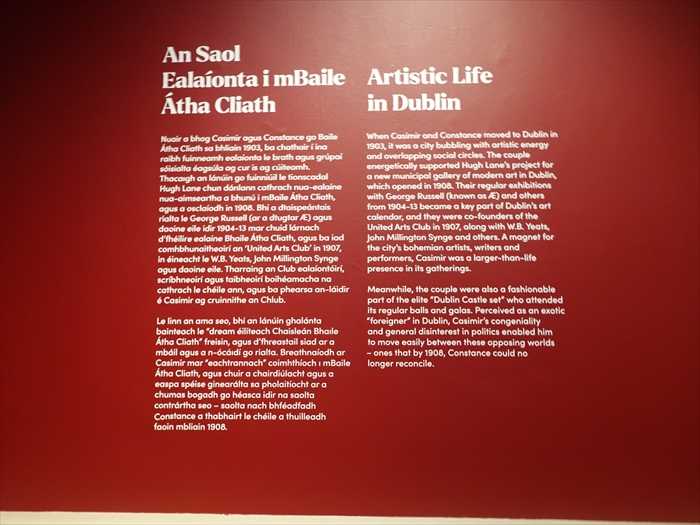

この肖像画は 「ミセス・エリー・ダンカン」 を描いたもので、
画家は <カジミール・ドゥニン・マルキェヴィチ伯爵(Count Casimir Dunin Markievicz)。

「 Casimir Markievicz
舞踏会や園遊会にも出席しました。異国の貴族としてのカジミールは名誉ある客として迎えられ
ましたが、政治と私生活の問題が重なった結果、この二つの重なり合う世界はもはや両立できなく
なっていきました。】

赤い壁面が印象的なダブリン城(Dublin Castle)内の展示室の一角。
カジミール・マルキェヴィチ(Casimir Markievicz)関連の展示エリア。

この肖像画は 「ミセス・エリー・ダンカン」 を描いたもので、
画家は <カジミール・ドゥニン・マルキェヴィチ伯爵(Count Casimir Dunin Markievicz)。

「 Casimir Markievicz
Portrait of Ellen Duncan (c.1913)
Oil on board. United Arts Club, Dublin
Ellen Duncan (1850–1937) was a central figure in the promotion of visual art in Ireland.
A champion of Hugh Lane and the effort to establish a gallery for modern art, she served
as the gallery’s first curator from 1911–1922. Casimir and Constance were also involved
with Lane’s campaign, and worked alongside Duncan on the foundation committee for
the United Arts Club, with Duncan appointed the Club’s honorary secretary in 1910.」
【 カジミール・マルキェヴィチ
A champion of Hugh Lane and the effort to establish a gallery for modern art, she served
as the gallery’s first curator from 1911–1922. Casimir and Constance were also involved
with Lane’s campaign, and worked alongside Duncan on the foundation committee for
the United Arts Club, with Duncan appointed the Club’s honorary secretary in 1910.」
【 カジミール・マルキェヴィチ
エレン・ダンカンの肖像(約1913年)
板に油彩 ダブリン、ユナイテッド・アーツ・クラブ所蔵
エレン・ダンカン(1850–1937)は、アイルランドにおける視覚芸術振興の中心的存在でした。
彼女はヒュー・レーンと、近代美術のためのギャラリー設立の取り組みを支持し、1911年から
1922年までそのギャラリーの初代キュレーターを務めました。カジミールとコンスタンスも
レーンの運動に関わっており、ユナイテッド・アーツ・クラブ設立委員会でダンカンと共に
活動しました。ダンカンは1910年、このクラブの名誉書記に任命されました。】

ヴワディスワフ伯爵の肖像(1860)。

「Boleslaw Szańkowski
彼女はヒュー・レーンと、近代美術のためのギャラリー設立の取り組みを支持し、1911年から
1922年までそのギャラリーの初代キュレーターを務めました。カジミールとコンスタンスも
レーンの運動に関わっており、ユナイテッド・アーツ・クラブ設立委員会でダンカンと共に
活動しました。ダンカンは1910年、このクラブの名誉書記に任命されました。】

ヴワディスワフ伯爵の肖像(1860)。

「Boleslaw Szańkowski
Portrait of Count Władysław (1860)
Oil on canvas, Local Family Collection, Poland
Boleslaw Szańkowski (1873–1953) was a leading Polish portrait painter who studied
in Munich under... He continued his studies in Paris before moving to St Petersburg,
becoming the French court's official portraitist. He was finally to settle in Warsaw i
n the 1890s.
in Munich under... He continued his studies in Paris before moving to St Petersburg,
becoming the French court's official portraitist. He was finally to settle in Warsaw i
n the 1890s.
[中略 – ピンボケで不明な部分]
Szańkowski also painted a number of works in Montparnasse, Paris, and in Warsaw.
In addition to portraits, he restored a number of important works in Poland.」
【 ボレスワフ・シャニコフスキ
ヴワディスワフ伯爵の肖像(1860)
キャンバスに油彩、ポーランドの地方家族コレクション所蔵
In addition to portraits, he restored a number of important works in Poland.」
【 ボレスワフ・シャニコフスキ
ヴワディスワフ伯爵の肖像(1860)
キャンバスに油彩、ポーランドの地方家族コレクション所蔵
お気に入りの記事を「いいね!」で応援しよう
【毎日開催】
15記事にいいね!で1ポイント
10秒滞在
いいね!
--
/
--
© Rakuten Group, Inc.




